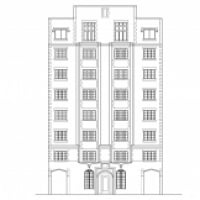Welcome! Here are the website rules, as well as some tips for using this forum.
Need to contact us? Visit https://heatinghelp.com/contact-us/.
Click here to Find a Contractor in your area.
If our community has helped you, please consider making a contribution to support this website. Thanks!
Mapping out my 1 pipe steam system
Options
usndave03
Member Posts: 35
Looking at the risers on my 1 pipe steam system makes me wish I had x-ray vision. I have tried to piece together the puzzle of how my risers/runners are laid out in the walls of my house. It would be nice to know how long risers are and which radiators they serve. I had someone banging on the base or the radiators while I listened in the basement to hear and identify their respective risers coming off the main. However, there are a few things that are puzzling me. I have 18 radiators in a 2 story house and only 17 risers coming off the main. Is it possible to have 1 riser feeding two radiators. One riser does not seem to connect to any radiator...is it possible that its feeding one of the other risers which is feeding 1 radiator? My house is almost 90 years old...do city building departments keep old schematics of heating systems that would answer many of my questions. I would like to accurately map out my system if possible.
0
Comments
-
It is possible that 1 riser is feeding 2 radiators, yes.
it is possible that 1 riser is feeding 0 radiators.
Anything is possible. Even my tiny house has 2 abandoned risers in the walls. My kitchen looked a lot different in 1915.
if your risers have valves in the basement like most of mine do, that may help you figure things out, if the valves workNJ Steam Homeowner.
Free NJ and remote steam advice: https://heatinghelp.com/find-a-contractor/detail/new-jersey-steam-help/
See my sight glass boiler videos: https://bit.ly/3sZW1el0 -
Fun, isn't it? Tracing old pipes in old walls... it certainly is possible that one riser could be feeding two radiators, most likely two which are quite close to each other (maybe on opposite sides of a wall?) If a riser doesn't feed any other radiator, it is likely to get hot much slower -- if at all -- as there wouldn't be any way for air to get out of it.
You will have better luck, incidentally, pounding on a riser in the basement and listening upstairs -- though both that and your technique can be misleading.
What you are doing is well worth doing!
And, if I may, may I suggest doing the same thing to the plumbing... which isn't always as obvious as one would want -- and to the electrical system, which can be anything but obvious.
As to the building department. It's unlikely in the extreme that they would have, never mind find, anything like plans -- even if they kept them (or even required them) for a residence in the first place. They might, of course, it never hurts to ask.Br. Jamie, osb
Building superintendent/caretaker, 7200 sq. ft. historic house museum with dependencies in New England0 -
Thanks for the insight guys...I'll keep banging and listening. @Jamie Hall , great idea on the plumbing and electrical. I actually started accurately labeling my breaker panels and it has definitely come in handy.
I think ill take a walk to the buildings dept and see what they got. Maybe I'll find out some interesting things about the house.0 -
An infrared thermometer that you can aim at walls to tell where the risers are might also be useful (obviously only when the system is running).0
-
@ChicagoCooperator nice, didn't think of that. Maybe I can get a buddy of mine from the fire department to bring over some of those thermo gadgets.0
-
That is a great idea for the fire dept and a thermal camera.
It actually could be an official training visit.
To be able to find hidden hot spots without an actual fire and under classroom conditions.
With the hot spot maybe only 210 degrees or less, it would be more challenging than actual smoldering fire. IMO actually better training.
I have the most basic FLIR camera and can see 160-170 degree hot water lines thru a wall. Or 110 degree tubing in concrete.
Just don't let them bring in axes or pike poles to verify their findings. 0
0 -
I just have one I got a Home Despot for not a whole lot of money. Very useful for finding failed traps.0
Categories
- All Categories
- 87.3K THE MAIN WALL
- 3.2K A-C, Heat Pumps & Refrigeration
- 61 Biomass
- 429 Carbon Monoxide Awareness
- 120 Chimneys & Flues
- 2.1K Domestic Hot Water
- 5.8K Gas Heating
- 114 Geothermal
- 166 Indoor-Air Quality
- 3.7K Oil Heating
- 77 Pipe Deterioration
- 1K Plumbing
- 6.5K Radiant Heating
- 395 Solar
- 15.7K Strictly Steam
- 3.4K Thermostats and Controls
- 56 Water Quality
- 51 Industry Classes
- 50 Job Opportunities
- 18 Recall Announcements


